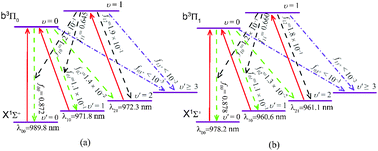Ab initio studies on the spin-forbidden cooling transitions of the LiRb molecule†
Abstract
The spin-forbidden cooling of the LiRb molecule is investigated based on ab initio quantum chemistry calculations. The multireference configuration interaction method is used to generate the potential energy curves (PECs) of the ground state X1Σ+ and the low-lying excited states a3Σ+, B1Π, and b3Π. The spin–orbit coupling effects for the PECs and the transition dipole moments (TDMs) between the X1Σ+, b3Π and a3Σ+ states are also calculated. The analytical functions for the PECs are deduced. The rovibrational energy levels, the spectroscopic parameters and the Franck–Condon factors (FCF) are determined by solving the Schrödinger equation of nuclear movement with the obtained analytical functions. The b3Π0 ↔ X1Σ+ and b3Π1 ↔ X1Σ+ transitions have highly diagonal distributed FCFs and non-zero TDMs, demonstrating that the LiRb molecule could be a very promising candidate for laser cooling. Therefore, a three-cycle laser cooling scheme for the molecule has been proposed based on these two spin-forbidden transitions. Using the radiative lifetime and linewidth calculated from the obtained TDM functions, we present further analysis of the cooling of LiRb and the corresponding KRb molecule. The transition b3Π0 ↔ X1Σ+ is found to be a practical transition to cool the LiRb molecule, and a sub-microkelvin cool temperature could be reached for the KRb molecule using a similar laser cooling scheme.


 Please wait while we load your content...
Please wait while we load your content...